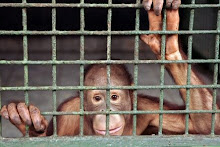On Day One of Animal Cruelty Trial, A Simple Question: How Hard Is It to Free a Trapped Cat?
| Tyrone McGill |
Displayed on several screens throughout the courtroom was the picture in question: that tiny hole in the flimsy sheet rock wall that was ultimately all it took to free a cat from where it had been trapped for at least 15 days. "It didn't take the jaws of life or fire and rescue to cut this hole," Alex said.
Instead, it took a knife from the euthanasia room and about 10 minutes to remove the corpse from behind the break-room wall, where it had gotten stuck after escaping from its cage some 15 days earlier. At that point, it was badly decomposed, its fur coming away in clumps. According to the testimony of animal cruelty investigator Domanick Munoz this afternoon, when found, the cat's nails were also worn down from jumping up and clawing against the wall in a desperate bid to free itself. Throughout this first day of testimony, from both the prosecution and the defense, a basic question arose: How could it be so hard to free a cat from a wall?
According to the prosecution, the answer lies with McGill, who, according to shelter employees, promised repeatedly to "take care of" the issue and then failed to act. According to former shelter worker Kimberly Killebrew and Munoz, McGill also discouraged shelter workers from taking direct action to free the animal. He implied that they would face termination for destroying city property if they did so.
"He was actually giving them a threat," Alex told the jury. "This wasn't a priority to him. He had the authority to stop the suffering, and on that Tuesday he flat-out told [Killebrew], 'We're not going to do it.'"
But throughout the day, defense attorney Anthony Lyons pointed out repeatedly that the same rules that forbid destruction of city property also prevented McGill and other supervisors from taking actions that could potentially endanger the safety of city employees. He also asked Killebrew, Munoz and another shelter worker who testified today, Adam Cooper, why they hadn't considered it their responsibility to free the cat.
"You testified to the jury about how concerned you were about that cat," he said to Killebrew. "So why didn't you cut a hole in the wall?... You just testified, blaming him for not doing it, why didn't you do it?" Furthermore, he said, McGill had made efforts to free the cat, including lifting ceiling tiles and calling Equipment and Building Services.
In his testimony, Munoz painted a picture of a dysfunctional climate where animal shelter employees were frightened to step outside the chain of command for fear of losing their jobs. The prosecution read portions of a scathing email he wrote to McGill and Munoz's own supervisor, Adrian Vela, on May 18, the day the rotting cat was ultimately removed from the wall. At that point, the smell of decomposing flesh was so strong it carried all the way down a long hall from the break room where the cat was walled up.
"Why is it so hard to have a cat removed from the wall, dead or alive?" Munoz asked. "... This is unsanitary, unhealthy, and socially unacceptable. ... Why are we turning a blind eye to this situation?"
The prosecution will continue to present its case tomorrow.

No comments:
Post a Comment